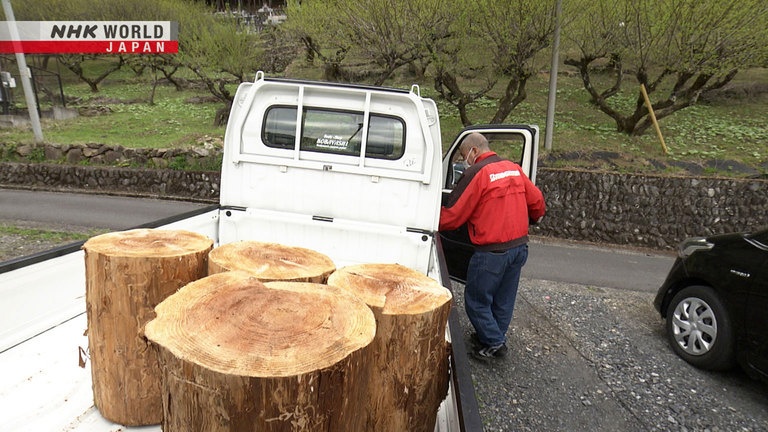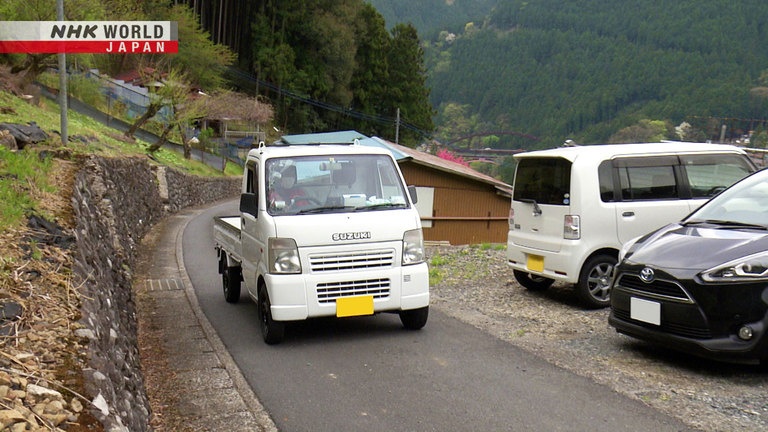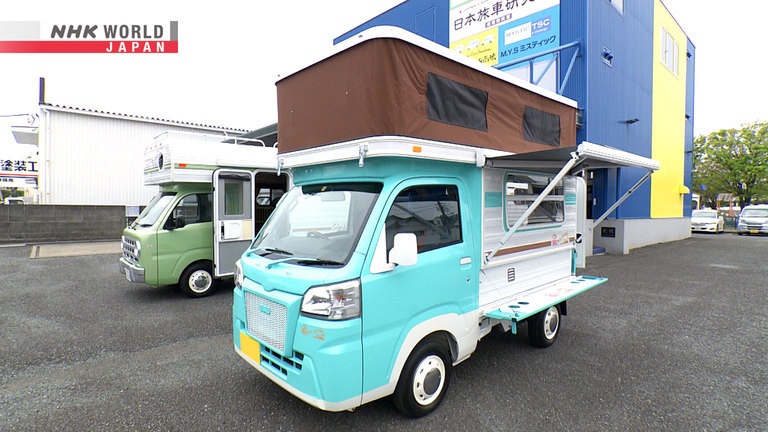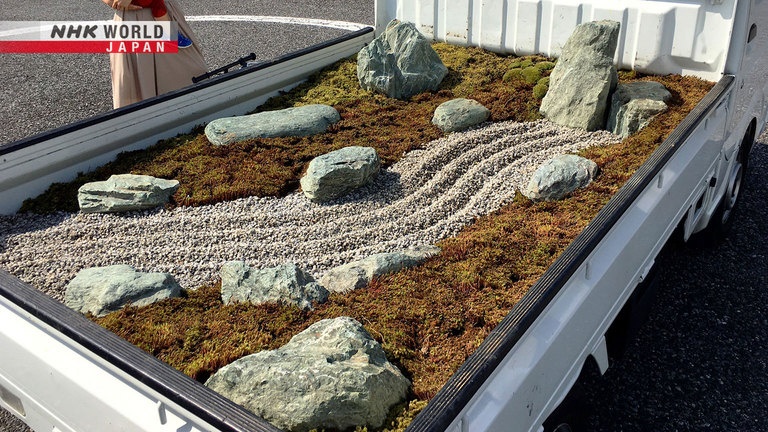Keitora: Tiny Trucks
*First broadcast on June 16, 2022.
40% of the motor vehicles in Japan are ultra-compact "kei" cars. These light vehicles are maneuverable, practical and cost-efficient. Tiny "kei" pickup trucks, known as "keitora," are especially common in rural Japan. They're perfect for narrow unpaved countryside roads. Our guest, motoring journalist Maruyama Makoto, shows us how "keitora" usage is diversifying in modern Japan. And in Plus One, Vinay Murthy makes a dry landscape garden on the back of a tiny truck.




Transcript
Hello, and welcome to Japanology Plus.
I'm Peter Barakan.
I'm at a second-hand car dealership that
specializes in what are known
in Japan as “kei cars.”
“Kei” means “light,”
and as you can see, these are
all pretty much ultra-compact size.
The kei category includes
passenger cars, vans,
and you'll see here,
these little pickup trucks.
By the way, you can tell any kind of
kei car by the yellow number plate.
Now these kei trucks,
abbreviated in Japanese as “keitora,”
are kind of the workhorses of rural Japan,
especially in areas like farming.
But in recent years,
they've also began to be used
in all kinds of other ways too—
as we shall find out in a minute.
OK, here we go.
Around 40 percent of the motor vehicles
in Japan are ultra-compact “kei cars”—
made to a uniquely
Japanese set of specifications.
They're no longer than 3.4 meters
and no wider than 1.48 meters,
with an engine no larger than 660 cc.
Despite their size,
on an everyday road they're just as fast
and functional as a regular car.
There are two main types of kei car:
passenger cars, and commercial vehicles.
The commercial category includes
pickup trucks and mini vans.
Today we're focusing on
light pickup trucks known as “keitora.”
They have two seats,
and an open cargo area.
Let's have a look at
what these vehicles actually do.
Lots of farmers use them
to carry agricultural produce.
That often involves travel
on unpaved and hilly roads.
Keitora are small and maneuverable,
making them ideal for these everyday uses.
Keitora are great in mountainous areas
with lots of rough roads.
If your truck gets dirty,
you can just hose the dirt off.
Keitora are so user friendly.
The cargo area is designed to
carry a load of up to 350 kilograms.
These trucks can fit into narrow spaces.
They're useful for
all sorts of little jobs.
Carrying cargo up a steep,
narrow road like this is no problem.
One application in coastal regions
is for the transportation
of freshly caught seafood.
Keitora are a common sight in cities, too.
They're perfect for narrow shopping
streets or residential areas.
The cargo area of these tiny trucks
can be easily adapted
to suit many different purposes.
For example, here's a mini fire truck.
It's used for
emergencies along narrow roads,
where a full-size truck
would be too big to fit.
Keitora have also long been used
for mobile catering.
This business serves steaming hot ramen
from the cargo bed of a tiny truck.
Here's a mobile supermarket.
It drives through lightly populated areas,
selling food and daily necessities.
In districts without a permanent shop,
these vehicles are a crucial lifeline.
In Japan,
keitora are a pillar of everyday life.
Maruyama-san, nice to meet you.
-Thank you for joining us today.
-Nice to meet you.
Our guest is Maruyama Makoto,
a motoring journalist
who's an expert on vehicles
in their Japanese cultural context.
This is the showroom of a car maker.
Here we have the very latest keitora.
A little surprised that they're not white.
My impression of kei cars is
they're overwhelmingly white.
Yes,
white keitora have always been common,
but recently we're seeing more variety.
And one reason is an initiative
introduced by the government.
The aim is to increase the number
of women working in agriculture.
That led to vehicle makers introducing
a broader range of colors.
Some models have
UV protection in the glass,
which helps to shield the skin.
This one has that feature.
The design of the cargo bed reflects
feedback from many Japanese farmers.
It's designed to accommodate the
containers commonly used in agriculture,
which come in set sizes.
It can carry 54 of these crates,
or 40 of these plastic tanks.
They fit perfectly.
All of that in one truckload.
A vehicle like this is a very efficient
way to ship agricultural produce.
Tiny trucks are designed
to seat two people.
And modern examples
are surprisingly roomy.
The seats recline.
And the door opening
measures 108 centimeters.
The floor is just 41.5 centimeters
off the ground.
Even in bulky work clothing,
you can climb in and out of
the vehicle quite smoothly.
Ah, so that's all
taken into the calculations.
Interesting.
Peter, why don't you put on
some boots and a hat,
and try getting in and out?
Thanks.
I feel like a total...
Oh, and the hat as well.
OK.
That's no good.
Go ahead.
So,
what do you think of these new keitora?
Yeah, it feels fine.
It's actually quite comfortable,
and there's plenty of leg room as well,
for a pretty small car.
It's obviously well designed.
Even with big boots on,
it's easy to climb into the cabin.
There's plenty of head clearance, too.
That's great for people wearing a helmet.
Ah, so in fact I should be wearing
a helmet rather than this cap.
I see—that was the point of that.
OK.
I get how these tiny trucks are very
convenient for farmers and fishermen.
But it seems like as soon as you leave
Tokyo and go out into the countryside,
sometimes perhaps more than
half the cars you see are these.
And I wonder what is the secret
of their popularity?
Well, I'd say they're perfectly
suited to Japanese roads.
Almost 70 percent of Japan's land
is covered in forest.
Most forest roads
end up being very narrow.
The same is true of many roads in flat
areas, because of housing and farmland.
For getting around on narrow roads,
keitora are really convenient.
Also, they're just so simple.
Two seats and a cargo area. That's it.
What's more, the cargo area
is a perfect, flat rectangle.
That makes it very easy
to customize a keitora.
The price is a big plus, too.
A regular car might set you back
two to three million yen.
But these tiny trucks can cost
less than one million.
Even the high-end ones
are only 1.6 or 1.7 million.
Yeah, that is pretty cheap.
And considering all the features that
they have, it really is very reasonable.
In terms of cost-performance,
it's hard to beat a keitora.
Mmm.
The history of keitora can be
traced back to the late 1950s.
At that time,
cars were considered a luxury.
Automobile makers
developed light “kei” cars
as an affordable option
for the general public.
At around the same time,
three-wheeler vehicles were developed
for transporting cargo.
They were maneuverable,
convenient and cheap.
These vehicles were immediately popular,
and became the precursor to keitora.
Sturdy four-wheeled tiny trucks
appeared in the 60s.
In situations ranging from public works
all the way through to family businesses,
they played a role in Japan's
quickly developing economy.
Technology continued to improve,
and in the 80s,
four-wheel-drives were introduced.
These vehicles could more easily tackle
unpaved, uneven roads,
and there was a huge demand
for them among farmers.
In rural communities,
keitora were so useful that
every household was said to have one.
From the mid-90s,
keitora came to be used in various
new ways—including mobile catering.
The start-up costs for
this kind of business are relatively low,
and so tiny trucks selling food and drink
became a common sight.
If you're outside an office block
at lunchtime,
or if you're attending a large event,
you're almost sure to see them.
Our next stop is Kanagawa Prefecture,
to see keitora
that epitomize the modern era.
Here we have a keitora
that's been turned into a camper van.
If you look at the side,
you'll see what's happening.
The shell of the camper van has been
added on top of the cargo area.
Oh right,
that's quite a cool customization.
If you take a closer look here,
you can see there's a retractable awning.
You can pull it out.
If you pull down this part, at the side,
it becomes a table.
A vehicle like this
is perfect for traveling,
or for people who want to do mobile sales.
Oh, that's kind of cool.
Since the outbreak of COVID-19,
camper vans like this
have become more popular.
It's a way for small groups
to travel privately.
People find that appealing,
and as a result demand is growing.
Next, we'll have a look inside.
This is Japan,
so let's take off our shoes.
Ah, OK.
Oh, it's quite low.
It doesn't feel like
a typical keitora at all.
It's...it's a little bit cramped isn't it?
I'm scared I'm going to hit the top
of my head on the ceiling here.
Then take a look at this.
You can actually raise up the entire roof.
Oh...haha! Wow.
You push it like this, and up it goes.
Oh, that's quite...actually impressive.
Yeah, absolutely,
I could probably stand up actually.
I can! I can totally stand up inside here.
That's amazing.
And now you have this platform here,
presumably you can sleep in here?
Yes.
You can sleep on this.
It slides all the way out here.
It's big enough
for an adult to lie down on.
Two people can sleep on the upper shelf.
And two more, if you lay out
padded mats in the space below.
Here's a similar vehicle.
This one also uses a keitora as a base.
But this time,
the modification on the back is
slightly wider than the rest of the truck.
So it isn't officially classified
as a “kei” vehicle.
Let's go in.
OK.
OK, this one's…
almost high enough to stand up in.
Oh, this is quite roomy though.
Yes, it's been extended...
That's right.
sideways, yeah.
There's kind of drawers here.
Oh OK, storage space.
Then...in fact there's storage space
just about everywhere, isn't there?
And even in sort of
fairly cramped Japanese houses
you'll see the same things,
where they utilize
every square centimeter of space
to put something away.
Yes, the space-saving measures
used in tiny houses in Japan
are put to great use here too.
Recently,
many people are converting their keitora
into a camper van by themselves.
This interior was inspired
by a traditional tea room.
Beneath the tatami mats,
there's plenty of storage space.
Here's an example
that was made by a father and son.
The layout features two fold-out beds
and their own choice of furnishings.
The result is their dream camper van.
Hi there.
I'm Vinay Murthy, and today I'm here
in Meiwa town in Gunma Prefecture.
So,
I heard that there's someone around here
who makes an interesting new kind of
artwork using Japanese kei trucks.
The artist in question is
a landscape gardener.
Oh, hello, I'm Vinay.
Nice to meet you.
Nice to meet you.
My name is Inada.
Let's go right ahead
and see Inada-san's artwork.
Here it is.
Oh, wow. What is this?
It's a keitora garden.
I've created a garden in the cargo area.
A kei-truck garden!
Yes.
A keitora's cargo area measures
1.4 meters by 2 meters.
Within this tiny area,
a keitora garden can showcase
Japanese aesthetics and engineering.
The concept began
at a gardening competition in 2011.
Participants could
prepare a garden in advance,
then simply drive it to the venue.
These gardens allow me to express myself.
And they become mobile demonstrations of
what we can do with full-size gardens.
Alright, well, do you think I could
try and make my own garden too?
Of course!
So where do I start?
What am I making?
Let's try a dry landscape garden.
Take a look at this photo.
The gravel is used to represent water.
So you can use the gravel
to depict rivers or the sea.
Oh, I see.
Here are the materials.
Using gravel, rocks and moss,
Vinay will build a representation
of a natural landscape.
OK, let's start with that one over there.
Vinay has selected his first rock.
And up it goes.
Its placement
must be carefully considered.
Which way round should it be?
I think this side is good,
so...this side facing out.
OK.
So I'm picturing a river
coming kinda like this.
Curving?
Yeah, let's curve that way.
And the width?
Yeah, how about...like this?
Got it.
OK, so the river will flow from here,
and hit a rock around here.
Then it will go in this direction.
So let's put some rocks
in the key locations.
So maybe one...
OK, yup.
That looks good.
Soil is used to
represent mountains and hills.
The soil is covered in moss.
It's patted down
to conceal the dividing lines.
OK so…
these rocks are like the water, right?
Yes.
Start from the top.
Pour the gravel
into the middle of the river bed.
You can add a little more.
Yes, like that.
Keep moving down the river.
Then finish it off.
The gravel is spread out flat,
then brushed with a spiked board
to bring the scene to life.
Not bad at all!
The raked gravel looks like flowing water.
Here's Vinay's
finished dry landscape garden.
My...image for this river is the Colorado
River in my home country, America.
Can't you tell?
Of course—it's unmistakable!
It's a great depiction of a river.
Well done.
Very atmospheric.
News of Vinay's accomplishment
spreads quickly,
and local admirers start gathering.
It depicts a river, without using water.
And it also seems kind of American to me.
It's a blend of two cultures.
That's really cool.
Inada-san, thank you so much for today!
Thank you for coming.
So, the things you can do
with a kei truck...who knew?!
If you have the chance to come to Japan,
definitely try to find one of
these amazing kei truck gardens.
So with these new developments,
like kei campers,
is there like a whole new market now
for kei trucks?
COVID-19 stimulated demand
for ways to avoid public transport,
and that did generate a few extra sales.
But overall,
the market for tiny trucks has shrunk.
What's the reason for that?
Fewer people work in agriculture,
where keitora are indispensable.
So there are simply fewer tiny trucks
than there used to be.
Also, as these trucks are cheap,
and not very profitable,
several companies
have stopped making them.
Only two Japanese manufacturers
are still producing them.
OK. So is that a result of Japan's
economy being pretty much in the
doldrums for the last 30 years?
That's certainly one factor.
Companies
can't raise their prices very much.
Their sales would plummet.
Although demand is falling overall,
tiny trucks are finding a new audience.
The pandemic has inspired
the creation of keitora offices.
These are being rented out by
a skiing hotspot in Niigata Prefecture,
as part of a drive
to promote working holidays.
Here's a city in Iwate Prefecture.
On the first Sunday of each month,
this street welcomes
a long line of keitora.
There are over 40 of them!
It's a market,
where local products,
including fresh vegetables and seafood,
are sold directly to customers
from the backs of tiny trucks.
The event is also popular among tourists,
and on busy days it attracts
as many as 10,000 people.
Sellers can simply drive to the market,
do business, and drive home again.
The idea has spread
throughout the country,
and similar events have been introduced
in over a hundred cities,
towns and villages.
Next, a town in Kochi Prefecture
that's famous for a river
with clear, clean water.
What's going on here?
It's a keitora sauna!
The idea came from Miyazaki Sei,
a local woodworker.
He was thinking of ways
for people to relax,
and ended up making a sauna
on the back of a tiny truck.
It seemed like a fun thing to do.
I did lots of research,
then set about making the perfect sauna.
Through word of mouth,
the sauna became a local hit.
It's expected to attract tourists too.
Once you've worked up a sweat, the river
is the perfect place to cool down.
Other communities along the river
are now exploring their own sauna ideas
as new ways to boost the local economy.
Are these Japanese kei cars
used in any other countries?
Yes. In the United States, for example,
some agricultural workers have found
tiny trucks to be a convenient way
of getting around their fields, and so on.
Really?!
Previously they may have used
vehicles like golf carts.
But keitora offer better protection
against the elements,
and air conditioning.
Wow.
That's interesting. I had no idea.
What kind of developments
in kei trucks would you like to see?
Keitora are designed
for the working world.
I hope that workers continue
to see them as loyal partners—
I don't want that to change.
I don't think we'll see a large increase
in the number of trucks,
but I think they will continue to evolve.
One new way of using keitora
is as a mobile home.
Like these?
Yes.
Some people actually
live in them, full-time.
Really?
I mean I can understand
going away for a weekend,
to go camping in one of these.
But to actually live in it…
that's pretty extreme.
But some people do it.
They're nomads.
They travel across the country,
working as they go.
People may well find some other ways
to make use of keitora.
And perhaps that will
improve demand a little bit, too.
OK, thank you very much.
Thank you very much.
It's actually quite comfortable.
I could use another few inches
for my legs though.